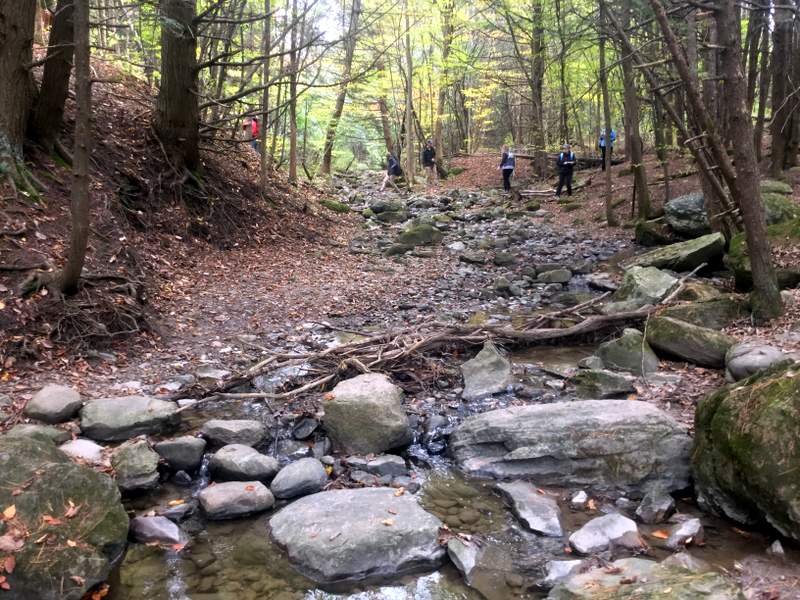Glacial Till
As previously discussed, the flow of glacial ice fractures off rock chunks from the bedrock forming roche moutonnees and glacial striations where there once was bedrock. As rocks entrained in the glacier scour down the bedrock, it abrades up the bedrock into small grains of clay, silt, or sand. Other non-glacial weathering processes also break up bedrock into smaller, loose pieces. So what happens to all that material, from the smallest grain of clay to the biggest boulders around?
Deposition of sediments in rivers
A river erodes away sediment as it flows downstream, so too does a glacier pick up and move material as it flows (valley glaciers flow downhill, ice sheets or continental glaciers flow out from the center of the zone of accumulation). Material caught in moving water is said to be entrained, or in transport and will only settle out of the water when it slows down (like when it hits a slower body of water, goes around a bend, or the grade becomes shallower). The drop in velocity is a drop in energy, and the heavier sediments drop out first, followed by a continuum of lighter and lighter materials, essentially sorting the materials as it flows.
Glacial till exposed by stream (a tributary of Potash Brook) in Wheeler Natural AreaTil
Deposition of sediments in glaciers
But advancing glaciers, unlike rivers, don’t sort, they plow. Think of a glacier as a behemoth train barreling along down the tracks, led by one of those big cowcatchers or cow plows at the front (those “V” shaped metal guards). And the tracks are unfortunately covered in all sorts of debris. As the train steams along, it rams into the debris, pushing some material out of the way, forcing some debris to squeeze underneath the cowcatcher, and plowing the rest downline out in front of the train. With glaciers, the stuff that gets run over becomes densely packed, unsorted material called till. The material that gets pushed along at the front of the glacier gets deposited at the terminus of the glacier in what’s called a terminal moraine. The materials pushed to the sides of a valley glacier are called lateral moraines.

Comparison of two types of stone wall made from different types of till. On the left (Leduc), smaller more rounded rocks, on the right more angular rocks (Shelburne Bay)
So whether the material winds up under the glacier, at its sides, or in the front, the material’s final resting place is separate from the bedrock from which it was derived. The farther a rock travels entrained in the glacier the smaller and rounder it becomes. The image above shows two different stone walls. The wall on the left, found at the Leduc Farm in South Burlington, is made of rounded rocks of a wide variety of rock types. The rocks are all pretty round. Compare this to a stone wall found at Shelburne Bay Park in Shelburne. These rocks are all derived from the local bedrock (Monkton Quartzite) and are all very very angular so probably didn’t travel very far at all.
Researchers have used this along with bedrock maps to reconstruct a rough map of the path the till took to get its current location. From this the direction of flow of the glaciers can be inferred. Most till represents rocks from 10-20 miles away – after 20 miles the rock would be abraded and broken down. But there are reports of some real long-distance vagrants like till found on Mt Mansfield that was reportedly from Canada (PDF).
Abundance of glacial till
The glaciers were a mile thick here in Vermont. That means that even our tallest peaks, which are just over 4000′ tall, would have been covered with 1000′ of ice! As a result, we see glacial till covering virtually every part of the state. The salmon pink color in the map above represents till. Everything that’s not till is exposed bedrock (where till has since eroded away) or sediments deposited on top of till by rivers, glacial lakes (more on this later), or the Champlain Sea after the glaciers had retreated. So much of Vermotn’s soils are till derived. You can download a higher res image of the map here.
Part of the reason we know the extent of the Laurentide Ice Sheet is from finding terminal moraines.







